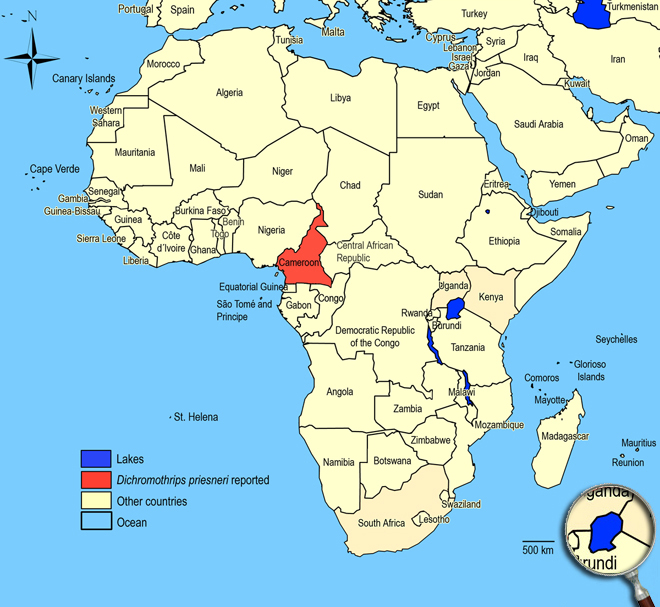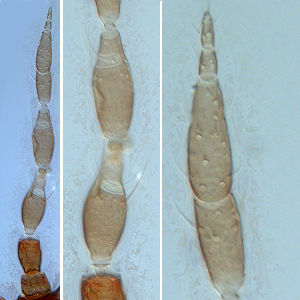Dichromothrips priesneri (Hood, 1938)
Thripinae, Thripidae, Terebrantia, Thysanoptera
Figures
Fig. 1: 8-segmented antenna, segments III and IV with forked sense cone, terminal segments V-VIII
Fig. 2: Head dorsal with ocellar triangle
Fig. 3: Pronotum
Fig. 4: Meso- and metanotum
Fig. 5: Fore wing, fore wing distal region
Fig. 6: Sternites VI and VII
Fig. 7: Tergites VI-VIII
Fig. 8: Tergites VIII and IX, VIII with posteromarginal comb
Fig. 9: Tergites IX-XI
Introduction and recognition
Dichromothrips priesneri breeds on the leaves and flowers of orchids. Both sexes macropterous; body color dark brown with bright vermilion internal pigmentation in thorax and abdomen; tarsi and apices of tibiae yellow; antennal segments I & II dark brown with vermilion pigmentation, III-VIII paler than I & II and without internal pigmentation; fore wings dark brown with a nearly colorless sub-basal area. Antennae 8-segmented; segments III & IV with apex narrowed and long forked sense cone (Fig. 1). Head distinctly wider than long; with 2 pairs of ocellar setae, pair I absent, pair III anterolateral to ocellar triangle (Fig. 2). Pronotum with transverse lines of sculpture near anterior margin; with 1 pair of elongate posteroangular setae (Fig. 3). Meso- and metafurca with median spinula. Metanotal median area transverse striate at anterior, but scarcely sculptured postero-medially; median setae arising behind anterior margin; campaniform sensilla present (Fig. 4). Mid and hind tarsi 2-segmented. Fore wing first vein with 2 setae distally; second vein with complete row of 12-14 setae (Fig. 5). Tergites without sculpture medially, but lateral thirds with many transverse lines (Fig. 7); VIII with a complete comb of long microtrichia and a group of microtrichia anterolateral to spiracles (Fig. 8); X without longitudinal split (Fig. 9). Sternites without discal setae; sternite VII with 2 pairs of median setae arising in front of posterior margin (Fig. 6).
Male tergite IX with no stout dorsal setae, but lateral and posteroangular setae sometimes stout; sternites III-VII usually with paired oval or round glandular areas which sometimes fuse medially.
Taxonomic identity
Species
Dichromothrips priesneri (Hood, 1938)
Taxonomic history
Taeniothrips (Eugeneothrips) priesneri Hood, 1938
Common name
-
Present taxonomic position
Family: Thripidae Stephens, 1829
Subfamily: Thripinae (Stephens) Karny, 1921
Genus: Dichromothrips Priesner, 1932
Genus description
The genus Dichromothrips Priesner, 1932
This genus includes nearly 20 described species from orchids in the Old World tropics, and an identification key to 14 of these is given by Mound (1976). Species within this genus generally have 8-segmented antennae, antennal segments III & IV with apex narrowed and long forked sense cone, 1 pair of long pronotal posteroangular setae (with the exception of Dichromothrips corbetti), a well developed endofurca spinula on the metathorax, a long and regular comb of microtrichia on tergite VIII, all of them lack ocellar setae I, and the metanotum is never longitudinally striate (Mound 1976; Mound & Kibby 1998).
Species description
Typical key character states of Dichromothrips priesneri
Coloration and body sculpture
Body color: mainly brown to dark brown
Surface of head, pronotum and fore legs: without obvious or with weakly reticulate sculpture
Antennae
Form of sense cones on antennal segments III and IV: emergent and forked on segments III and IV
Number of antennal segments: 8
Antennal segment I: without any setae on dorsal apical margin
Antennal segment II: without an exceptionally long seta at the inner apex
Antennal segment II shape: symmetric
Antennal segment III shape: symmetric
Length of antennal segment III and IV: antennal segment III similar in length to segment IV
Forked sense cone on antennal segment IV: extending to a point at least a third to base of segment V
Antennal segment IV and V: without a hyaline ring near the base
Antennal segment VI bears: not a remarkably dagger-shaped sensorium
Head
Distance between bases of ocellar setae III: greater than width of first ocellus
Head: not prolonged in front of compound eyes
Ocellar setae I: absent
Ocellar setae III: arising on anterior margin of, or in front of ocellar triangle
Ocelli: present
Length of postocular setae: not alternating short and long setae
Number of ocellar setae: 2
Prothorax
Number of pairs of long anteroangular setae: 0
Number of pairs of long posteroangular setae: 1
Number of pairs of elongate pronotal setae: 1
Pronotal blotch or internal apodeme: absent
Pronotum shape: broadly rectangular
Pronotum posteromarginal/posteroangular setae: S2 longer than S3, not equal in length
Mesothorax
Mesosternal furca: with median spinula
Metathorax
Metanotal campaniform sensilla: present
Metanotal median setae: S1 behind anterior margin
Metanotum with dominant sculptured triangle medially: absent
Metasternal furca: with spinula
Sculpture of metanotum median area: transverse at anterior, but scarcely sculptured on posterior half
Shape of metathoracic furca: transverse, V-shaped
Wings
Fore and hind wings: present, more than half as long as abdomen (macropterous)
Fringe cilia arising: from sockets
Fore wing veins: present
Fore- and hind wing surface: covered with microtrichia
Apex of fore wing: with prominent terminal setae
Fore wing anterior margin (costal vein): with setae and cilia but cilia longer than setae
Fore wing costal fringe cilia: arising at anterior margin of wing
Fore wing first vein: distinct from costal vein
Fore wing first vein setal row: incomplete, with setae not closely and uniformly spaced
Fore wing number of setae of second vein: 12-14
Fore wing second vein setal row: complete, setae uniformly spaced
Fore wing shape: mainly parallel sided or margins run continuously towards each other
Fore wing surface: not reticulate
Fore wing first vein number of setae on distal half: 2
Fringe cilia on posterior margin near apex: distinctly wavy (undulated)
Length of fore wing costal setae at middle of wing: longer than half of median wing width
Shape of fore wing apex: with mainly posterior margin curved to join anterior margin
Fore wing extreme apex color: dark
Fore wings: uniformly dark or shaded, but with base or sub-base pale
Legs
Fore tibia: not prolonged around fore tarsus
Mid and hind tarsi: with two segments
Color of fore tarsi: pale or yellow, sometimes apical shaded or brown
Abdomen
Pleurotergites: not covered in microtrichia
Sternite II: with marginal setae but no discal setae
Sternites IV, V and VI: with marginal setae but no discal setae
Sternite VII median posteromarginal setae S1: arising in front of posterior margin
Sternite VII: with marginal setae but no discal setae
Surface of lateral thirds of abdominal tergites: without regular rows of fine microtrichia
Tergites II to VII median setal pair: no more than 0.3 as long as median length of tergite
Craspedum on tergites IV to VI: absent
Tergites IV and V median setal pair: shorter than distance between their bases
Tergites V to VII: without ctenidia laterally, but sometimes with rows of microtrichia
Tergite VIII ctenidia: without paired ctenidia laterally, sometimes with irregular microtrichia
Tergite VIII posteromarginal comb of microtrichia: present and complete medially
Tergite VIII shape of posteromarginal microtrichia: long, slender and irregular or regular
Craspedum on tergite VIII: without craspedum medially and toothlike microtrichia laterally
Tergite X: not tubular, longitudinally incomplete
Setae on abdominal tergite X: all setae slender

Similar or related species
Dichromothrips priesneri is similar to Diarthrothrips coffeae and Scolothrips rhagebianus in having 8-segmented antennae with forked sense cone on segments III and IV, meso- and metasternal furca with median spinula, in lacking regular rows of fine microtrichia on lateral thirds of tergites, and lacking ctenidia laterally on tergites V-VIII. Compared to Dichromothrips priesneri, Diarthrothrips coffeae and Scolothrips rhagebianus possess 2 pairs of elongate posteroangular pronotal setae, 3 pairs of ocellar setae on head, and tergite VIII without a posteromarginal comb of microtrichia. Whereas Dichromothrips priesneri has 1 pair of elongate posteroangular setae on pronotum, 2 pairs of ocellar setae on head, and tergite VIII with a complete posteromarginal comb of long and slender microtrichia.
Biology
Life history
As with other thrips species the life cycle from egg to adult is dependent on temperature. The full cycle can take less than one week to over a month and adults may live for more than one month producing several generations in one year depending on seasonal weather (Lewis 1973).
Host plants
Breeding on the leaves and flowers of Orchidaceae,
orchids.
Vector capacity
None identified, but possible mechanical distribution of phytopathogenic fungi and bacteria.
Damage and symptoms
-
Detection and control strategies
-
Additional notes
-
Biogeography
Africa. Cameroon (Ossidinge).
African countries where Dichromothrips priesneri has been reported

The species Dichromothrips priesneri was not observed in surveys undertaken in East Africa on vegetables and associated weeds and crops.
Please click here for survey sites of all observed thrips species of Kenya, Tanzania and Uganda.

Bibliography
Hood JD (1938). A new subgenus and species of Thysanoptera from the Cameroons. Proceedings of the Biological Society of Washington. 51: 11-14
Lewis T (1973). Thrips: their biology, ecology and economic importance. Academic Press Inc., London Ltd., 349 pp
Moritz G (2006). Thripse. Pflanzensaftsaugende Insekten, Bd. 1, (1. Auflage). Westarp, Hohenwarsleben, 384 pp. ISBN-13: 978 3 89432 891 7
Moritz G, Morris DC & Mound LA (2001). ThripsID - Pest thrips of the world. ACIAR and CSIRO Publishing Collingwood, Victoria, Australia, CDROM ISBN 1 86320 296 X
Moritz G, Mound LA, Morris DC & Goldarazena A (2004). Pest thrips of the world - an identification and information system using molecular and microscopical methods. Centre for Biological Information Technology, University of Queensland, Australia, CDROM ISBN 1 86499 781 8
Mound LA (1976). Thysanoptera of the genus Dichromothrips on Old World Orchidaceae. Biological Journal of the Linnean Society. 8 (3): 245-265
Mound LA & Kibby G (1998). Thysanoptera: An identification guide, (2nd edition). CAB International, Wallingford and New York, 70 pp
----
Web links
Mound´s Thysanoptera pages
Thysanoptera Checklist
ICIPE Thrips survey sites
UNI Halle & Thrips sites
Thrips of California












